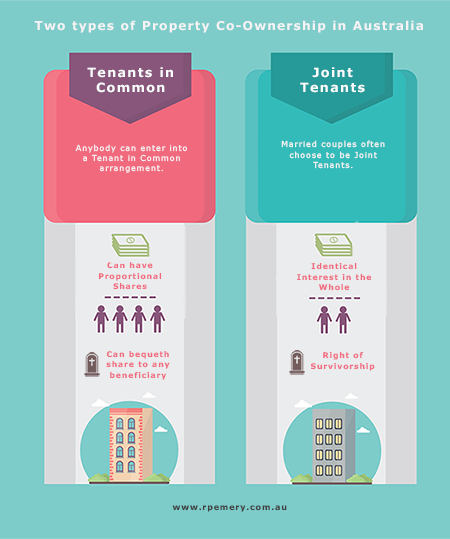The two main types of co-ownership in Australia are:-
- Tenants in common; or
- Joint tenants.
When you purchase a property with someone else, you can nominate how your interest in the property will be held: either as joint tenants or tenants in common. This will be recorded on the Certificate of Title.
Whether you elect to co-own as tenants in common or joint tenants, will depend on your situation and who you will co-own your property with. You can co-own real estate with:-
- your spouse – the most common form of joint tenancy is as between couples;
- your family (parents, children or siblings) – most often as tenants in common;
- your business partner – generally as tenants in common; or
- an investment partner (who may also be your family) – generally as tenants in common.
So what is the difference?
In both methods of ownership, each party has an interest in the whole of the land, as opposed to a designated portion of the land.
Joint tenancy is almost exclusively used by couples as a form of property ownership. If one of the spouse parties dies, then his or her share will pass automatically to the remaining spouse party.
This is called a right of survivorship
This ‘right of survivorship’ exists with ownerships of ‘joint tenancy’ only.
There is no right of survivorship associated with tenants in common. This gives each co-owner the ability to bequeath their share of the property to a nominated beneficiary in their Will.
Joint tenants are not able to bequeath their interest in the property in their Will – it will always go to the surviving co-owner/s. The last surviving co-owner, however, will be able to gift the property in his or her Will.
For this reason, it is common that property held by couples in a second marriage, is held as tenants in common. This ensures that each spouse party can bequeath their share of the property to their children.
Ability to define ownership shares with tenants in common
Joint tenants cannot nominate ownership shares. All co-owners who hold as joint tenants have an undivided interest in the whole of the property which will pass to the surviving owner/s on their death.
Tenants in common is a more flexible arrangement in that you can specify the ownership shares in which the property is being held. Usually this is defined as being proportionate to each parties’ contribution to the acquisition of the property.
For example, if each party contributed equally to the property, then they would register their ownership as ‘tenants in common in equal shares’. If one party contributed 25% and the other 75% towards the property, then this arrangement would be reflected on the title. If no percentage ownership is nominated, then the property will be deemed to be owned in equal shares.
Update your Will if you hold property as ‘tenants in common’
Co-owners who hold as tenants in common can bequeath their share of the property in their Will to selected beneficiaries. If there is no Will, the property will be subject to state specific intestacy laws.
Joint tenants cannot bequeath their interest in the property in their Will, as their interest will automatically pass to the surviving joint tenant.
Severing a joint tenancy
It is possible to alter the ownership method by completing and lodging the relevant form with the Land Titles Office.
In particular, a joint tenancy can be severed, to create a tenancy in common.
Divorce or separation
Consider taking immediate steps to sever a joint tenancy if you hold property as ‘joint tenant’ with your spouse and your relationship has ended or you are in the process of separating.
Investors or family members who co-own property together
It is increasingly common for friends or family members to invest in property together as a means of getting into the property market. More often than not, investment property, even among family members, is held as tenants in common for the reasons listed above.
If you have invested in property together with family, friends or business partners, consider putting in place an Agreement between Tenants in Common.
The Agreement will set out the terms governing the co-ownership of the property, including such things as:-
- The ownership proportions;
- The contributions each party agrees to make towards the maintenance, upkeep and repair of the property;
- Insurance requirements including taking out life insurance over the other co-owners so that the surviving owners can buy out their share on death;
- What happens if a party defaults under the mortgage;
- What happens if a party wishes to sell their interest in the land;
- How the property can be used;
- How will disputes among co-owners be settled – mediation and arbitration;
- How will sale proceeds be divided if the property is sold.
Addressing these issues upfront will help ensure the relationship between the co-owners remains a success.
More information
Investing with friends and family: a way to afford the great Australian dream
Property co-ownership: a team effort – why two or more owners are better than one


